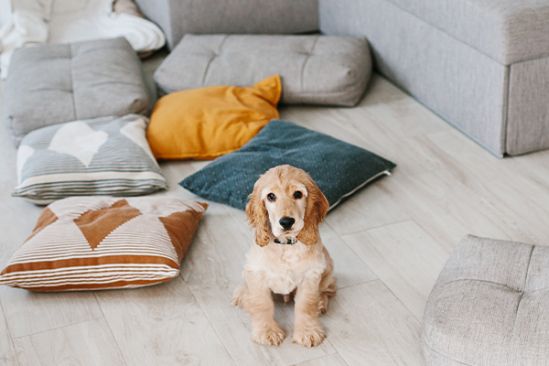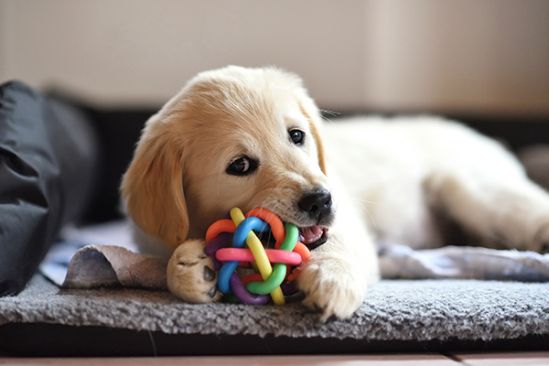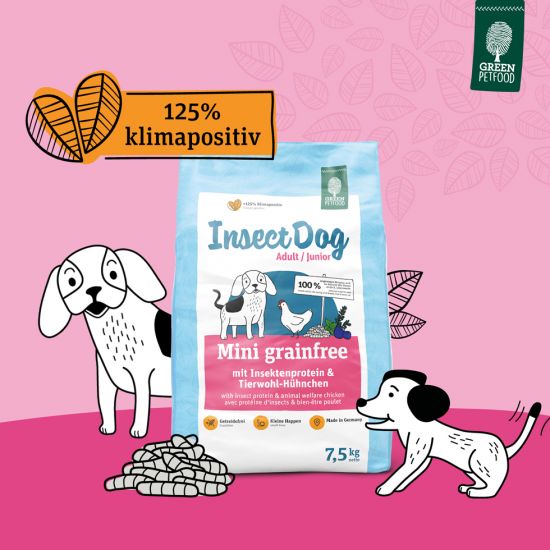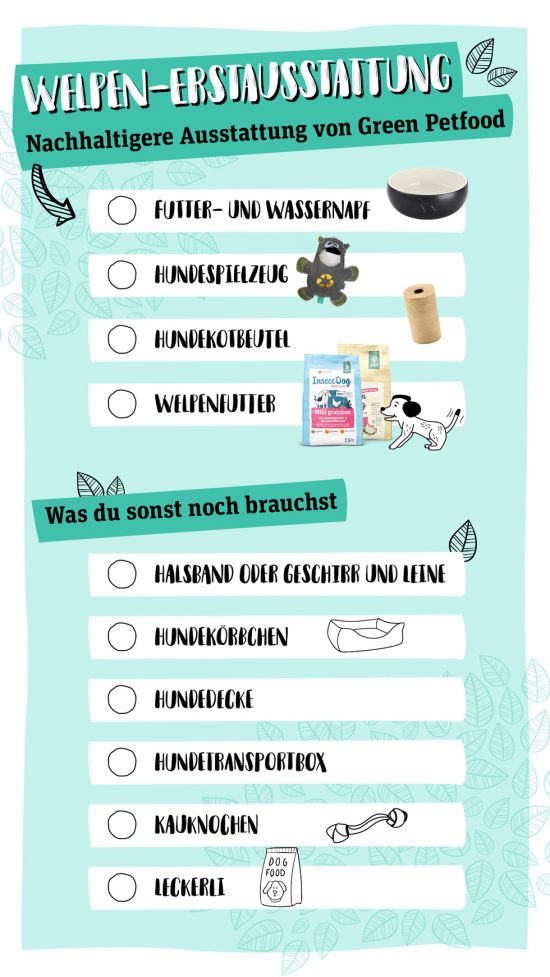How to prepare for a puppy — what you need for the perfect start
Your heart leaps with joy, the excitement mounts: soon a new puppy will be moving in with you! It’s a huge step! After all, a puppy turns everyday life upside down; a new life is beginning — for you and your dog. To make sure you get off to a great start with your new pet, it is vital to keep a cool head (at least to some extent) however much excitement and anticipation there is! Even before your new companion moves in, there are a few things to think about.
By carefully considering what to buy for a new puppy, it will be much easier for both of you to enjoy your early days together. If you are prepared for all your little dog’s everyday needs by the time it arrives, that leaves you free to concentrate on getting to know each other.
But what is the recommended basic kit for a new puppy? What do you need to buy, what is optional, and how might you do things more sustainably? And what else should be on your preparing for a puppy checklist?
A puppy is arriving: the excitement is mounting
A puppy’s arrival is a moment of great joy. The next few days and weeks promise plenty of excitement and you will have lots of new experiences. And the joy is not short-lived: a dog will be with you for 12-20 years! All the more reason to eagerly anticipate finally welcoming your new family member. You’ve chosen a dog that suits you perfectly and are in regular contact with your breeder or an animal rescue centre. If you have opted for a dog from a breeder or an animal shelter, you have no doubt already visited a couple of times to get to know the parents or maybe even your very own young puppy. And your phone is bound to be full of cute pictures of your sweet bundle of joy. In short: during the period leading up to your puppy’s arrival you will probably be incapable of sitting still. And it’s a good job too because there is a lot to prepare.
What to buy for a new puppy
There is a huge array of puppy products on offer. But before you bound off to your nearest pet store and are overwhelmed by the options, we recommend carefully considering what you want to acquire and what you don’t need. Some things are definitely essential basic puppy equipment, but others are superfluous — and when it comes to sustainability, less is sometimes more. If you are wondering what to buy for a new puppy, we have all the information you need.

- Dog basket: a comfy place to settle down in every room is something most puppies will appreciate. Some also like a dog box to retire to. Caution: puppies like to explore their surroundings with their teeth. So don’t spend too much on your dog’s first bed as it will no doubt soon show traces of your puppy’s curiosity.
- Dog blanket: a soft blanket is a great alternative to a dog basket or a perfect way to make a dog box or basket a little bit cosier. Lots of retailers sell dog blankets made from natural materials, for example using sheep or camel’s wool, and using organic products. These items are more sustainable than blankets made from synthetic fibres.
Feeding bowl and water bowl: the thing to consider here is acquiring the right size. If it is too big, your puppy may put its front legs into the bowl and the meal will become a whole-body experience! There is also a risk of mess with a bowl that is too small as the food can spill over the edge. The ideal size is a bowl that will be 2/3 full when the food is served. Since puppies shouldn’t stoop too low when eating, a feeding station might be a good plan. Are you good at making things? In which case, a DIY puppy feeding station could be an excellent and inexpensive idea! The stability of the bowls is also important. Some bowls are designed with rubber studs, others are made from heavy ceramic — the more stable the bowl is, the better.

- Dog toys: from shoes to sofa cushions. As far as a puppy is concerned, all your home furnishings are potentially exciting playthings! A better solution is to give your new puppy its own toys right from the start, so the concept of “mine” and “yours” is firmly established. But there is no need to get a vast array of items. A sturdy rope toy and/or an indestructible rubber ball are ideal basic puppy equipment. Since some dog toys contain toxic plasticisers and pollutants, you should make sure any plastic items you purchase are marked as “BPA free” or restrict yourself to toys made from natural materials. If you have creative talents, you can make your own puppy toys — old hand towels or clothing are an excellent craft material here.
- Dog transport box: a safe way to travel by car with your inexperienced passenger is to use a dog transport box. You can find real bargains online via second-hand retail portals. Alternatives include using a strap or dog guard.
- Dog poop bags: many towns and cities provide dog poop bags free of charge to make it as easy as possible for you to clean up after your dog when out walking. However, these plastic bags are rarely designed with sustainability in mind. If this issue is important to you, equip yourself beforehand with a more environmentally friendly alternative, e.g. biodegradable dog poop bags.

- Dog chew bones: to protect table legs and cushions from your young dog, make sure the urge to chew is satisfied with a nice bone. You can offer your dog a bone to chew on from the age of 12 weeks. When purchasing, make sure the dog chew does not contain any artificial additives and is a suitable size for your puppy’s needs.
- Treats: the way to a dog’s heart is through its stomach. Healthy, nutritious snacks are a great way to inspire your new family member to learn. That’s why it’s always a good idea to have a couple of treats handy.
- Puppy food: ideally the breeder will have already introduced your puppy to your chosen puppy food. This makes the transition easier when your dog moves in. At any rate — a good-quality puppy food is an essential part of your basic puppy equipment.
Sustainable tips on how to prepare for a puppy
Here and there we have already mentioned this issue, but this is something that is relevant for almost every product in your basic puppy equipment. If sustainability is important to you, try to find environmentally friendly options. This might be second-hand products, particularly durable products, or products that have been made in a more sustainable manner. Did you know that on average a dog’s accessories are the source of almost 30% of its CO2 pawprint, and its food represents 63% of this figure? So, you can save money and help protect the environment by resisting the temptation to buy the very first thing that comes along.
Interested in more sustainable puppy equipment?

Insect food for puppies as a sustainable alternative — but is it healthy?
Just like accessories, there are more sustainable options to consider when it comes to puppy food.
Our InsectDog Mini grainfree contains ethically farmed chicken, which is sourced locally, plus insect protein, which creates significantly less CO2 than the production of conventional protein sources.
The kibble in this mini feed are small enough to fit in every puppy’s mouth.
If you are worried that insect food might not supply sufficient nutrients for your growing dog, we can put your mind at rest.
The recipe has been formulated according to scientific criteria to ensure an optimal supply of all the nutrients your growing puppy needs from the 8th week of life.
Tip
As well as being an excellent form of simple food, dry kibble makes a wonderful snack substitute for rewards and games. Just divide up the daily food ration and use some for catching, hide-and-seek games, or as a reward during training sessions with your cheeky little pup.

What to buy for a new puppy: the key items
Needless to say, alongside the truly essential basic equipment, there are all sorts of other items that could be included on a list of puppy kit.
For example, a brush or tick remover are recommended but are not necessarily required right from the start.
Some people swear by a hot-water bottle for the puppy’s basket to imitate the warmth of the dog’s siblings and make the transition easier.
Others position a ticking alarm clock under the dog’s blanket to simulate the absent mother’s heartbeat, and some even take a comforter that has absorbed familiar canine smells to the dog’s new home so their pet can enjoy a “homely” aroma.
How necessary these items are is a matter of opinion.
What really matters in terms of making the move easier for your puppy are: patience, time, consistency and pleeenty of love
On the safe side — preparing for a puppy checklist
Find out what the legal situation around dog ownership looks like in your country. In some countries, for example, you will need dog liability insurance. Others impose a dog tax, which means your dog will need to be registered. In other countries, you will need to get a dog license or certificate of competence before acquiring a new puppy. Depending on the country, there may be different rules about mandatory use of dog leads. For example, are there special rules requiring dogs to be on a lead during the breeding and nesting period in spring? Where can your dog run off the lead?
Have you done all the paperwork? In which case, it’s time to puppy-proof your home! There’s no doubt that young dogs are blessed with enormous curiosity. For this reason, you should make sure:
- toxic houseplants, foods and medication are moved out of reach
- your garden is secure (so the puppy can’t escape)
- high-quality carpets and floor coverings are protected until the puppy is house-trained
- interior décor and furnishings are puppy-proof (risk of chewing!)
- steep steps are protected with a guard
- power cables are hidden away or protected against chewing
You should also ideally talk to your neighbours before acquiring your dog. Particularly during the settling-in period, your puppy may well express noisy displeasure if you leave home without him. By talking to your neighbours in advance, you can head off any potential disagreements.
The process of settling in a new puppy takes a few weeks — allow as much time as you can to make the arrival as easy as possible. Book time off work well in advance and avoid scheduling important appointments during the early period together — this time should be devoted exclusively to the two of you.
The first visit to the vet should wait until your puppy has got used to the new environment. Nevertheless, it is not a bad idea to check which vets in your local area have capacity to take on new dogs. Similarly, you should also have some emergency numbers handy. Nobody wants anything to go wrong, but if the worst was to happen you will be prepared.
If you are really keen, you could also check whether there is a dog training school in your local area. But remember to let your puppy have a relaxing arrival before you consider any dog obedience classes!
Tip
Awwww! Puppies are soooo cute, you’ll want to capture every single moment for posterity. With this in mind, make sure you clear plenty of space on your phone or digital camera for huge numbers of dog photos!
The early days with your new puppy
The big day has finally arrived, and you can collect your puppy from the breeder. It’s all incredibly exciting and it takes a while for it to sink in: “Wow, I am now mum/dad to a puppy!” What a fantastic feeling!
When you first get home, your puppy should be given enough time to explore all the rooms in peace and get to know his new living environment. Feel free to show him particular rooms, but let your puppy inspect everything at his own pace. Perhaps he will automatically settle down on his little bed or find his feeding bowl all by himself.
The main thing during these first few days is to use the time to establish a bond between you. This can be done with long periods of playing and cuddling. But you shouldn’t expect too much during this early period: let your dog relax before you start teaching basic commands. Don’t worry. You will get a feeling for when your puppy is ready.
You can be a playful role model for your dog and be patient if it takes a while for your puppy to be house-trained. The same applies if walking on a lead doesn’t go perfectly right away because everything outside is so fascinating. It is quite likely that your puppy will initially be restless and may cry for its siblings in the night. If you remain calm and exude confidence, this will abate over the coming days.
In summary
Small dog, big step: when a puppy moves in, everything changes! To make sure you get off to a great start, there are various things you can prepare beforehand. Once you have figured out what to buy for a new puppy, you can enjoy the settling-in period together with no distractions! You can make sure everything is ready with the right kit, the ideal puppy food, a puppy-proof home, and a certain amount of official paperwork. But in terms of how to prepare for a puppy, by far the most important thing is: patience, time and a whole lot of love!





















